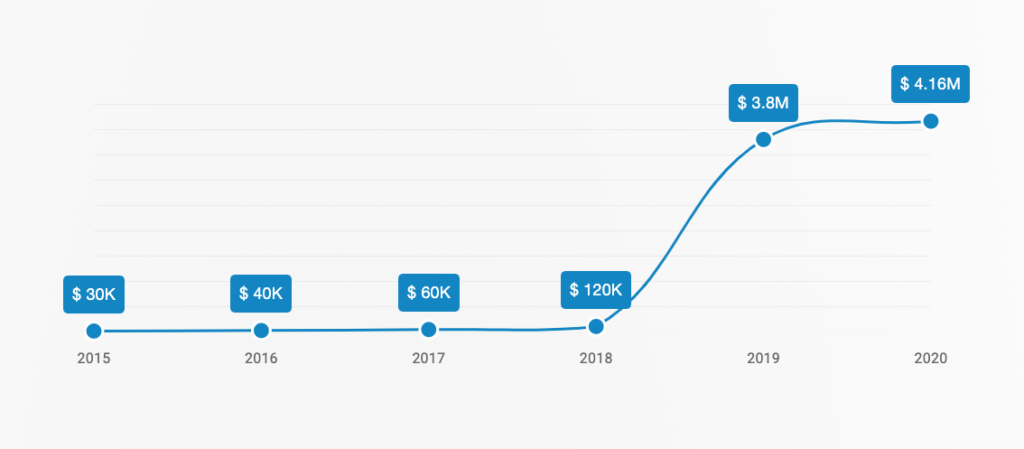How IT Can Benefit from Organizational Charts
Last updated January 31, 2021.
Most IT departments look very different from the way they did just a decade ago. There are new roles, new organizational structures, and new tools that are used to manage and maintain the networks and systems within organizations of all sizes.
Whether you’re an internal IT team or one that provides IT services to third-party companies, having a complete IT organizational chart is critical for giving yourself a birds-eye-view of your operations.
Modern IT teams are big, lumbering departments. You’ll have individual teams that specialize in specific tasks, systems, architectures, and platforms. The degree to which each team collaborates with other teams may depend on the requirements of individual projects. Their collaboration might be sporadic. They may or may not be used to working together or know who to reach out to in order to have specific questions answered.
As IT departments and organizations change with the times, their need for reliable documentation increases as well. Modern IT organizations are agile, shifting with the needs of the company. In some organizations, this means rapid changes that can be difficult to keep track of.
In this article, we’ll detail how modern IT departments are changing, how those changes alter the jobs of management, and how an IT organization chart can improve productivity and streamline communication between individual teams.
Let’s get started.
First-Generation IT Organizational Structures
IT organizational structures change just as quickly as the technology that they work with. In some IT departments, the shape of their organizational structure might look very different from the way that they did just a few years ago.
First-generation IT organizational structures differed quite a bit from the type of structures that we see employed today.
Some of the key differences between early IT organizations and today include:
- Business relationship handling has changed—In early IT departments and organizations, business relationships were often handled by the app developers or other technical specialists themselves. Over time, we’ve seen these duties moved to other departments, often as a go-between between IT departments and the organizations that they work with.
- Legacy development drove solutions—First-generation IT teams were often slaves to legacy development. They had to work on and within dated systems that may or may not have modern bells and whistles to facilitate productivity and production. While many companies still use their legacy systems, they often play a smaller role than they did in first-generation systems.
- Innovation less of a necessity—Because those teams were often hamstrung by the legacy systems their company used, innovation played a less critical role — both for their own company and their ability to compete within their marketplace. Innovation today is critical in IT teams of any size, both in providing solutions as internal teams and working as an IT vendor with a third-party client company.
- Operations worked with customers—First-generation IT teams didn’t have the separation of technical and customer-facing roles that we see today. Operations often had to both get their hands dirty in the technical aspects of their service and work directly with customers. Today, those roles are almost always separated in larger organizations.
So, as you can see, the role of IT organizations has shifted in recent years. With it, the challenges of managing an IT team have shifted as well.
Let’s take a look at the unique challenges that CIOs and IT department heads face in the modern marketplace to understand how an IT Organization chart could benefit them.
Challenges Facing CIOs
Chief Information Officers (CIOs) have seen their positions change rapidly in recent years. IT teams have ballooned as companies adopt new systems, ditch legacy systems, and are forced to compete in an increasingly complex marketplace that demands more from information technology teams.
In this section, we’ll break down how the changing IT industry has created some unique challenges, concerns, and requirements of CIOs that can be helped with a well-maintained IT organization chart.
- Alignment
- Legacy Systems Holding Them Back
- Demand Outpacing Capacity
- Expectation Setting
- SaaS Adoption
- Decreased Relevance
1. Alignment
Alignment is always a concern for CIOs and IT team management teams. As the responsibilities of the department as a whole continue to grow, creating that alignment between separate IT teams becomes increasingly difficult.
Two teams may work in the same department, but have very little overlap between their duties. In fact, two separate teams may never work together until a specific project comes along. Without that previous interaction, facilitating healthy communication and alignment between the teams is often a struggle.
Further, the IT teams of today are instructed to prioritize innovation. They aren’t just supposed to monitor the systems they are responsible for, they are supposed to find new ways to improve the department and their organization over time.
IT teams are expected to increase their value year over year. They are tasked with coming up with new innovations and consistently working to improve the department. CIOs and IT managers are expected to facilitate that change.
2. Legacy Systems Holding Them Back
Migrating from a legacy system to something more modern can be a costly endeavor. Often, instead of upgrading, CIOs are stuck incrementally upgrading systems and making small changes to modernize them as best they can over time.
Still — a system that was coded 25 years ago can only be made so modern through updates. Legacy systems can be a drag on innovation and productivity. They can keep companies from attracting fresh qualified candidates, who often are more interested in flashier startups or more interesting projects.
3. Demand Outpacing Capacity
The demands and requirements of your average IT department have grown rapidly over the course of the last decade. With more software options available to companies—driven by the boom of the SaaS industry that is supposed to reach a market valuation of more than $180 billion by 2024—IT professionals are forced to be fluent in more platforms than ever before.
It’s difficult for most companies to keep up. The IT industry is hungry for new talent across many different disciplines, and many IT departments get used to operating with personnel gaps. Often, team members are expected to cover multiple roles in the department with others to help. It can be exhausting. Most companies are never truly able to get off the IT hiring treadmill.
4. Expectation Setting
“You’re too expensive.” That’s something that many outsourced IT teams get used to hearing. The truth is that many CIOs spend a lot of their time setting realistic expectations for IT projects. How long they will take. How much they will cost. How much hardware they will need to invest in.
For some reason, many executives see IT as the perfect department for cutting corners and reducing costs. They’ll opt to invest in low-quality hardware. They’ll postpone upgrades to critical systems. They’ll slow budget growth in IT compared to other departments.
All of this leads to a lot of stress on a CIO and a need for organization within their department. An IT organization chart can be a great investment for any company that would like to help others understand the scope of projects.
5. SaaS Adoption
SaaS adoption is on the rise. Soon, many companies will be running purely on SaaS solutions. Companies that are still on legacy systems will be presented with a huge challenge as their competitors gain access to more feature-rich solutions while enjoying the agility that a SaaS-driven model provides.

It’s predicted that Enterprise firms (1,000+ employees) will spend an average of $4.16M on SaaS in 2021. Image used courtesy of Insivia.
CIOs around the country are being pushed toward SaaS. The adoption of these solutions can be slow-going for companies that have never made large-scale migrations before.
To ease this transition an IT organization chart can be a useful tool. Not only will it help IT departments to improve their cross-team communication at a critical time, but it will give CIOs a top-down view of their talent that can help them to fill in gaps as they seek out new solutions.
6. Decreased Relevance
There will always be room for certain IT jobs. Networks need people to maintain them. Employees will always need help with their equipment. But overall, IT departments are seeing themselves fall out of relevance in the business sense. CIOs are the last lifeline to the executive suite, but even they are often deprioritized behind the CTO, CMO, and other C-suite positions.
That, combined with the fact that new-generation employees tend to be more technology-literate – the demand for customer support techs has decreased in most organizations. More often, an employee at the desk a few steps away can help them solve their problem in a matter of seconds rather than a matter of hours if they were to submit a support ticket.
This decreased relevance is a challenge and concern for any CIO, who wants to make the value of their department clear. Using tools like IT Organization charts to show exactly where resources are allocated and where gaps in your workforce can be an effective way to advocate.

What Are the Benefits of an IT Org Chart?
There are many benefits that IT organizations and departments will find from using an IT organization chart. Using Organimi, you can keep your organization chart updated through a simple drag-and-drop online interface while collaborating with partners in the process.
You’ll never have to worry about making sure that you are editing the right version, have multiple people working on edits at a time, or find yourself unable to keep up with a rapid hiring spree that leaves your org chart outdated.
Some of the benefits that any IT department or service providing organization will enjoy from using Organimi’s IT organizational charts include:
- Improved communication—Our solution provides simple, quick access to communication information for anyone listed on your IT org chart. Email and phone number can be added for every person included on your chart. You can also add custom fields so that you can track other communication systems like Slack, Skype, and any other tool that your company uses to keep in touch. The improvements in communication will be felt across your department, as employees can quickly identify the right person to contact for each question.
- Better tracking of resources and specializations—Want a complete birds-eye-view of your IT team? As the adoption of SaaS products becomes the industry-norm, it makes sense that it would become increasingly difficult to keep track of who
- Improved employee onboarding—Your IT organization chart will also improve employee onboarding. They’ll be able to familiarize themselves with the who’s who if the department, know who to contact with specific questions that they might have about their new position, and generally be more communicative throughout the onboarding process.
- More agile decision-making—The complete view of your IT organization that a chart provides allows you to make smart, data-backed decisions on the fly. You can see where your resources are being deployed. You can more easily identify where there are shortages and where you are overloaded with talent. For CIOs and IT department heads that are visual learners, a chart gives them a new way to process employee information that can be extremely helpful.
- Improve adoption of new technologies—Knowing where, when, and how to deploy internal assets is critical for the smooth adoption of new Saas technologies. With many companies in a rush to move away from legacy systems and toward more modern SaaS solutions, an IT organization chart can be an effective tool to provide more context to the decisions that you make.
These are just a few of the many benefits provided by organizational charts.
More Visibility, More Productivity
An IT organization chart provides more visibility into your IT operations and teams. That visibility allows for improved communication, better decision-making, and provides useful content to new employees to help with improving new hire onboarding.
Organimi makes creating your own IT org chart easy. Our drag-and-drop interface and .CSV imports make it simple to load a list of employees, then work together as a team to collaborate on the org chart moving forward.

